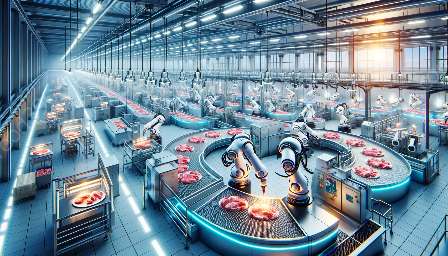In recent years, robotics has played a transformational role in the meat industry, particularly in the handling and sorting of meat products. This technology has brought about significant advancements and improvements in meat processing, from streamlining production to enhancing food safety. In this article, we will delve into the world of robotics for meat handling and sorting, examining how it is compatible with meat robotics and automation as well as its impact on meat science.
The Rise of Meat Robotics and Automation
The use of robotics in the meat industry has seen a steady rise, driven by the need for increased efficiency, precision, and hygiene. Automated systems are now being integrated into various stages of meat processing, including handling, sorting, packaging, and distribution.
The primary goal of meat robotics and automation is to optimize the entire meat production process, from the initial stages of carcass handling to the final packaging of meat products. This has led to a decrease in manual labor requirements, improved product consistency, and enhanced food safety standards.
Benefits of Robotics in Meat Handling and Sorting
Robotics has revolutionized meat handling and sorting by offering a wide range of benefits to meat processors and consumers alike. One of the key advantages is the minimization of human intervention in tasks that are physically demanding and carry a higher risk of work-related injuries.
Additionally, robotic systems are capable of handling various types of meats with precision and speed, leading to increased production output and reduced operational costs. The integration of advanced vision systems and artificial intelligence has further enhanced the accuracy of sorting and grading processes, ensuring that only high-quality meat products reach the market.
Enhanced Food Safety and Quality Control
With the implementation of robotics, the meat industry has witnessed a significant improvement in food safety and quality control measures. Automated handling and sorting procedures minimize the potential for contamination and cross-contamination, thereby reducing the risk of foodborne illnesses.
Furthermore, robotic technologies enable the real-time monitoring of meat products, allowing for early detection of any deviations from quality standards. This proactive approach to quality control ensures that only safe and compliant meat products are made available to consumers.
Meat Robotics and Automation in Research and Development
Meat science has been greatly influenced by the advancements in robotics and automation. Researchers and food scientists are utilizing robotic technologies to explore new methods of meat handling, sorting, and processing. By leveraging automation, they can conduct precise experiments and studies to optimize the sensory attributes and nutritional composition of meat products.
Moreover, the use of robotics in research and development has paved the way for the creation of innovative meat processing techniques, leading to the introduction of novel products that cater to evolving consumer preferences and dietary trends.
Future Implications and Innovations
As the field of robotics continues to evolve, the future implications for meat handling and sorting are vast. Advancements in machine learning and robotics are expected to further enhance the adaptability and flexibility of automated systems, allowing for seamless integration with diverse meat processing operations.
Furthermore, the convergence of robotics with other emerging technologies, such as Internet of Things (IoT) and blockchain, holds the potential to revolutionize the entire meat supply chain. From farm to fork, these technologies can ensure transparency, traceability, and sustainability, contributing to a more efficient and trustworthy meat industry.
Conclusion
The integration of robotics in meat handling and sorting has ushered in a new era of efficiency, precision, and safety within the meat industry. By aligning with meat robotics and automation principles and contributing to advancements in meat science, robotics is poised to continue driving positive changes in meat processing, ultimately benefiting both producers and consumers.

